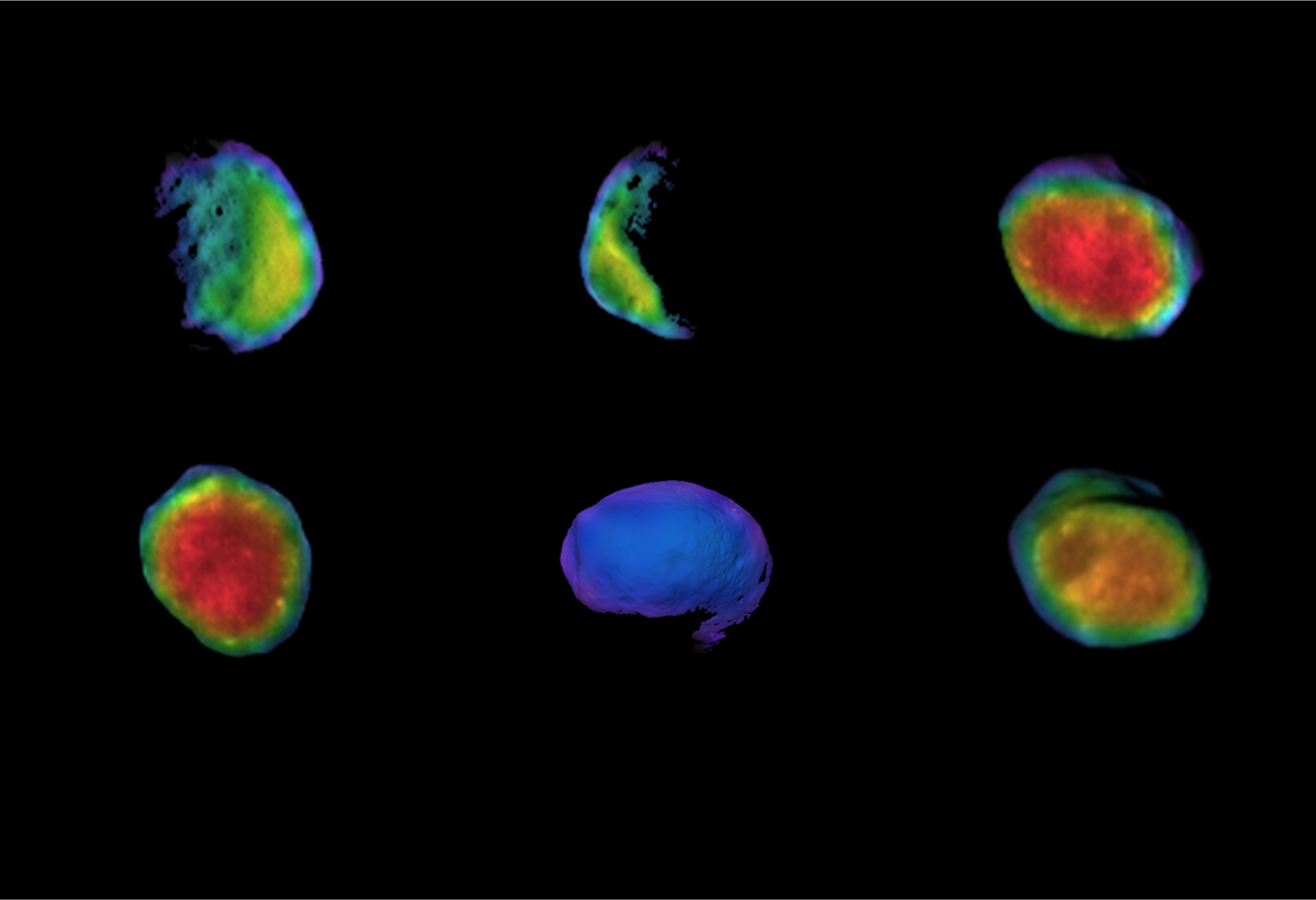
New thermal imagery paints the Mars moon Phobos in a candy-colored light.
NASA's Mars Odyssey spacecraft, which has been orbiting the Red Planet since 2001, used its infrared camera to measure temperature variations on the 16-mile-wide (25 kilometers) Phobos at three different stages of illumination.
An image captured on Dec. 9 of last year shows Phobos in full sunlight, with a maximum measured temperature of 81 degrees Fahrenheit (27 degrees Celsius). A second shot, taken on Feb. 25 when the moon was in full eclipse, registered temperatures as low as minus 189 degrees F (minus 123 degrees C) — some of the lowest ever recorded on Phobos, Mars Odyssey team members said.
Related: Mars' moons: Facts about Phobos and Deimos
The third new image, taken on March 27 when Phobos was coming out of Mars' shadow, observed temperatures between those two extremes.
Lots of information about the moon can be gleaned from the thermal imagery, which NASA officials released Tuesday (June 9).
"We're seeing that the surface of Phobos is relatively uniform and made up of very fine-grained materials," Christopher Edwards of Northern Arizona University in Flagstaff, who leads the processing and analysis of the Phobos images, said in a statement.
Get the Space.com Newsletter
Breaking space news, the latest updates on rocket launches, skywatching events and more!
"These observations are also helping to characterize the composition of Phobos," Edwards said. "Future observations will provide a more complete picture of the temperature extremes on the moon's surface."
A more complete picture could, in turn, help astronomers better understand the history of Phobos and Mars' other moon, the 8-mile-wide (13 km) Deimos. Some scientists think the satellites are captured asteroids, but others argue that they bothcoalesced from material blasted off the Red Planet's surface by powerful impacts.
Mars Odyssey's infrared camera is known as the Thermal Emission Imaging System, or THEMIS for short. The newly released infrared imagery does not show Phobos as it would look to the human eye.
"All of the THEMIS infrared images are colorized to show temperature variations and are overlain on THEMIS visible-light images taken at the same time to show the geology of the surface," NASA officials wrote in the same statement. "The one exception is the eclipse image, which is computer-generated and shows what Phobos would have looked like if it wasn't in complete shadow."
Mars Odyssey is primarily devoted to studying the Red Planet's surface. But the probe has also studied Phobos in recent years, a target switch that requires flipping the probe upside-down.
Though Odyssey remains in good health, it's unclear how much longer the orbiter will continue doing its work (which also includes relaying communications between mission control on Earth and robots on the Martian surface, such as NASA's rover Curiosity). The 2021 federal budget request allocates just $1 million to the project next year, a more than 90% cut that, if enacted, would effectively end the Odyssey mission.
- Mars Odyssey: Pictures from longest Mars mission
- Japan to launch a sample-return mission to Mars moon Phobos in 2024
- A brief history of Mars missions
Mike Wall is the author of "Out There" (Grand Central Publishing, 2018; illustrated by Karl Tate), a book about the search for alien life. Follow him on Twitter @michaeldwall. Follow us on Twitter @Spacedotcom or Facebook.
OFFER: Save 45% on 'All About Space' 'How it Works' and 'All About History'!
For a limited time, you can take out a digital subscription to any of our best-selling science magazines for just $2.38 per month, or 45% off the standard price for the first three months.
Join our Space Forums to keep talking space on the latest missions, night sky and more! And if you have a news tip, correction or comment, let us know at: community@space.com.

Michael Wall is a Senior Space Writer with Space.com and joined the team in 2010. He primarily covers exoplanets, spaceflight and military space, but has been known to dabble in the space art beat. His book about the search for alien life, "Out There," was published on Nov. 13, 2018. Before becoming a science writer, Michael worked as a herpetologist and wildlife biologist. He has a Ph.D. in evolutionary biology from the University of Sydney, Australia, a bachelor's degree from the University of Arizona, and a graduate certificate in science writing from the University of California, Santa Cruz. To find out what his latest project is, you can follow Michael on Twitter.










